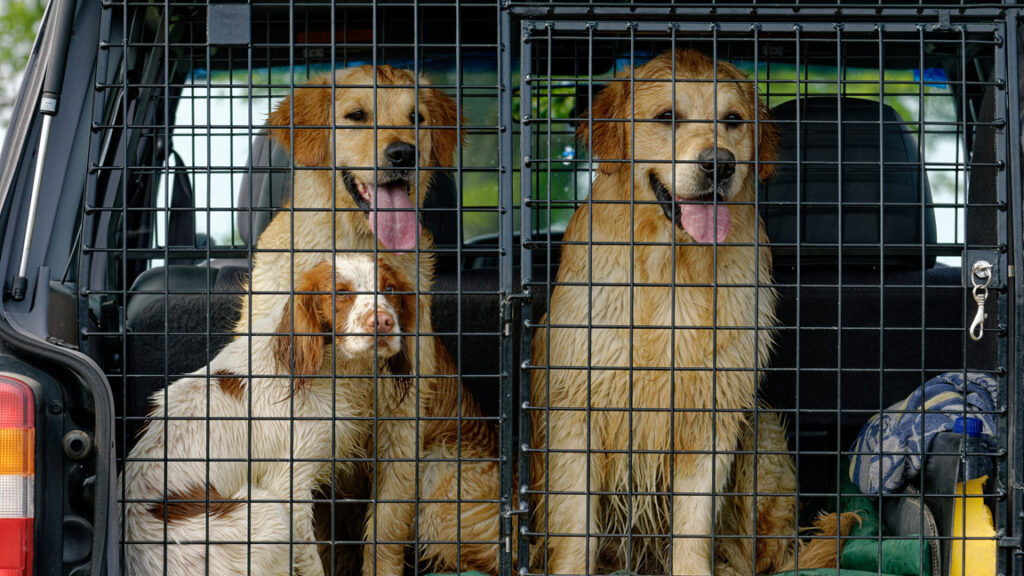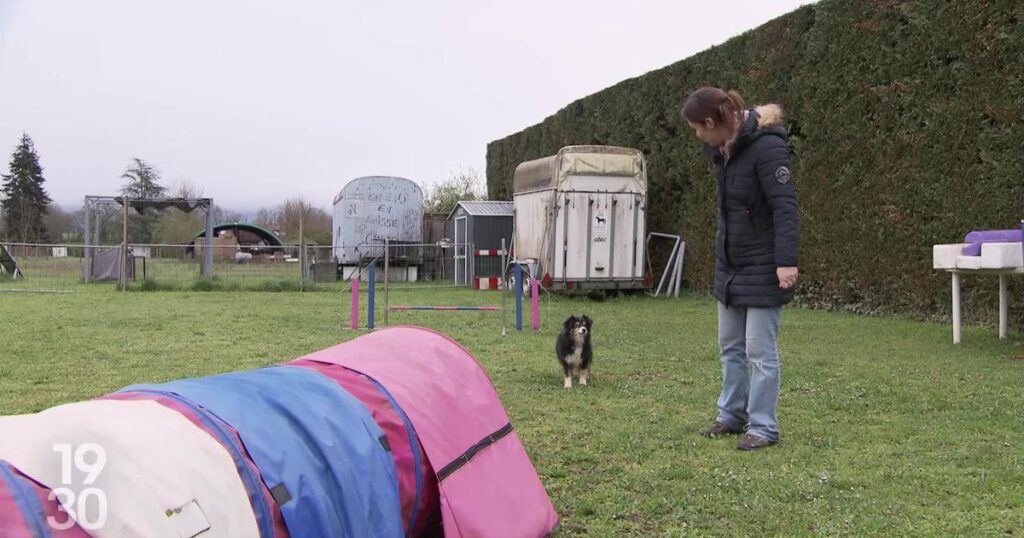
A female dog's gestation lasts about two months, usually 50 to 70 days after mating. Learn to recognize the signs of pregnancy in order to care for your pet until giving birth. Owner, or simply curious, this article will provide you with essential information on this wonderful adventure. Furthermore, you will discover the possible risks associated with this physiological status, since pregnancy is never trivial. Discover all the tips to help you take care of your dog during pregnancy and giving birth.
The first step to understanding pregnancy is identifying the signs that your dog is pregnant. A pregnant dog presents numerous physiological and behavioral transformations. Here are some common signs to watch for:
- Behaviour change : this is one of the first signs of gestation. She can become more cuddly, calm or, on the contrary, more agitated.
- Weight gain : a pregnant dog gains weight as the gestation progresses. The belly becomes rounder, it is particularly visible from the 45th day.
- Swollen udders : the bitch's udders become larger and darker due to increased blood flow.
- Vomiting and nausea : some female dogs show symptoms similar to pregnancy in women.
- Increased appetite : the pregnant dog shows less interest in food, especially at the start of gestation, due to nausea. However, she may also eat more than usual.
- Reduction in activity : your dog rests more, she may also refuse to go for a walk.
- Vaginal discharge : discharge may appear at the end of the first month of gestation and the vulva takes on a darker shade.
- Nesting behavior : when the birth is near, the pregnant female works in her basket to prepare a nest for her young.
If you observe any of these signs, it is time to consult a veterinarian to confirm your dog's pregnancy.
Until 19 to 21 days of gestation have passed, it is impossible to make a clinical diagnosis of pregnancy in the female dog.
Behavioral changes, udder development, and appetite variations are not reliable signs, as they also occur in pseudopregnancy. Weight gain, on average 35%, only occurs during the second month of gestation.
Although rare, serous or whitish vulvar discharge may appear on the 25th day of gestation. Be careful not to confuse them with pyometra, a very serious condition of the uterus.
It is recommended to consult a veterinarian for additional examinations:
- Ultrasound : it is advisable to wait until the 25th day before carrying out this examination. This makes it possible to assess the vitality of the fetuses and detect any anomalies. Precise counting of the number of fetuses is unreliable (60% errors on average, often due to underestimation of the number). This is particularly the case in large dogs or when the number of fetuses is greater than 5.
- Relaxin dosage : this test can be carried out from the 25th day, but must be repeated one week later in the event of a negative result.
- X-ray : from the 45th day, the mineralization of the fetal skeletons makes it possible to establish a certain diagnosis of gestation. In addition, it allows for a much more precise count of the number of fetuses.
Pattounes in your mailbox?
Let's go !
What are the stages of a dog's pregnancy?
The “real” gestation period is on average 60 days from the day of mating. A female dog's pregnancy is divided into three distinct thirds, each characterized by specific developments:
- First third (days 0-21) : this phase begins with the fertilization of the eggs. Embryonic cells divide rapidly. Early signs of gestation, such as weight gain and behavioral changes, are often more pronounced at this stage.
- Second third (days 21-42) : During this period, the puppies begin to form and take on distinct characteristics. The female dog may have increased nutritional needs because puppies grow quickly. A balanced diet is essential.
- Third third (days 42-63) : the puppies are entering a major growth phase and the female dog is showing signs of preparing to give birth. She looks for a comfortable place to give birth, and her udders can produce colostrum, the first milk.
It is essential to follow the development of the pregnancy week by week, closely monitoring the health of the female dog. Regular visits to the veterinarian are recommended to ensure everything is going well.
What specific care should be given to a pregnant female?
During your dog's gestation, special care is necessary to ensure her health and that of her puppies. Here are some tips for caring for a pregnant female:
- Adapted diet : choose a quality diet adapted to the nutritional needs of the pregnant dog. The ration must be rich in protein, but also digestible and balanced, to support the growth of the puppies.
- Adapted treatments : It is strongly recommended not to administer medications to a pregnant dog due to the associated risks. The use of inappropriate medications can have serious consequences for the fetus. However, it is possible to deworm the mother three weeks before giving birth and up to three weeks after the birth of the puppies.
- Preparing for birth : Create a comfortable and safe space for birthing. Keep an eye on your female dog for any signs of distress or complications.
- Moderate exercise : avoid activities that are too intensive for your female, calm walks are important to maintain her physical condition.
Risks incurred during gestation
Abortions
They may be due to an infection or a combination of other causes.
They can be caused by bacteria, viruses or parasites. Only an analysis will make it possible to determine the nature of the infectious agent. The most common causes include salmonella and streptococci.
Other causes: Trauma, poisoning and problems of genetic origin should be taken into consideration.
Certain medications in particular can cause abortions:
– corticosteroids
– aspirin
– vitamin A overdose
– tetracyclines
Always read the instructions for use carefully. It is important in the context of breeding to understand the reasons for an abortion in the female dog. Your veterinarian will help you with this. The first measure is the analysis of the expelled fetus(es).
Accidents of gestation
Apart from abortion, incidents can be responsible for blocking gestation. The young can die and give rise to a uterine infection, endangering the life of the female. These accidents often occur in the second month of gestation.
Ectopic gestation
True ectopic gestation, that is to say the development of the embryo outside the uterus, is very rare in bitches. It is much more often a rupture of the uterus at the end of gestation.
The fetuses are then found in the abdomen and, unable to continue their development, they dry out. A phenomenon of mummification occurs which can go unnoticed because the dog remains in good health. A uterine infection can follow the rupture of the uterus; surgical intervention is then necessary.
Uterine torsion
One of the two uterine horns turns on itself. This condition is very painful and surgical intervention must be rapid.
Hernia of the uterus
The gravid uterus, very heavy, passes through the groin, exits the abdomen and forms a large ball on the inner side of the thigh. Normal development of puppies is possible but a cesarean section is required for delivery.
Supergestation
There is a very particular phenomenon in female dogs called “supergestation”. After mating, the heat does not stop and the female can be mated again in the same cycle by another dog. She will therefore be able to have babies from two different fathers in the same litter, the first mating not stopping ovulation. You must, therefore, be very vigilant after a mating with a purebred dog, and watch for the “rough guy” who may pass by!
Likewise, the female dog can be taken from the start of the cycle or at the end of the cycle. If there are very favorable periods, that does not mean that there is no risk outside of these.
When the puppies are expelled, it is common for the female to lose a dark green liquid, coming from the pigments contained in the placenta. This shade may be surprising at first, but is completely normal.
Most of the time, puppies are born in their fetal sheaths, translucent membranes similar to thin skin. When they are born, they are still connected to their placenta by the umbilical cord. The expulsion of a fetus generally takes place within a few minutes.
Shortly after all puppies are born, the mother consumes the placenta and cuts the umbilical cords. Novice female dogs may be less skilled compared to those who have already had litters.
Do not intervene excessively to avoid disrupting the birthing process. However, careful monitoring of the birthing process should be carried out, particularly to ensure that the puppies are not crushed by their mother.
What to do when giving birth to a female dog?
Parturition is a crucial moment in the gestation process. Here are some essential steps to follow:
- Set up a space for birthing : choose a quiet, clean place where the dog feels safe. Using a whelping crate with raised edges is recommended to prevent puppies from falling.
- Build an emergency kit : also prepare clean towels, sterilized scissors, disposable gloves and equipment recommended by your veterinarian. Keep the numbers of your veterinarian or emergency clinic handy in case of complications.
- Monitor the birth : during work, remain calm and observe its progress from a distance. Generally, female dogs are able to handle the situation on their own. However, be prepared to intervene if you notice signs of distress in the mother or puppies.
- After giving birth : Make sure puppies are nursing properly and staying warm. Monitor the mother and puppies carefully during the first few weeks.
- Veterinary follow-up : schedule a consultation after giving birth to check that the mother and puppies are doing well. Take this opportunity to discuss the nutrition of the nursing dog.




